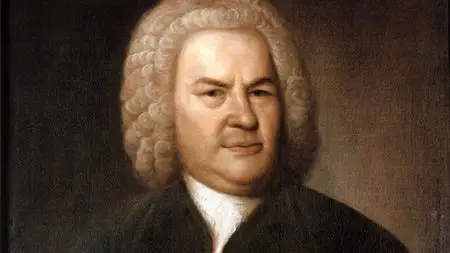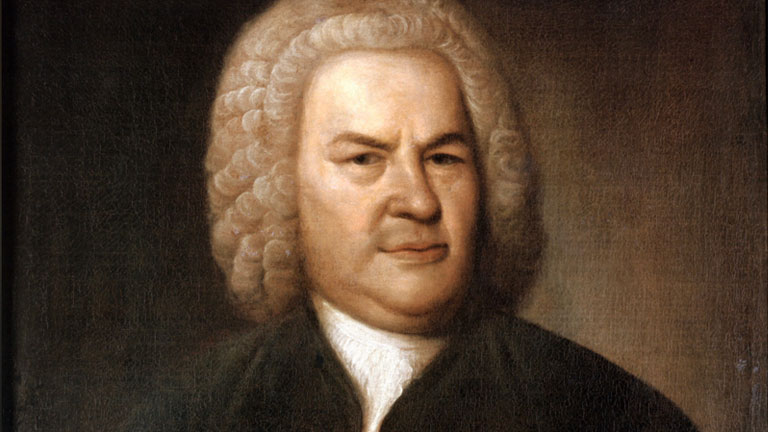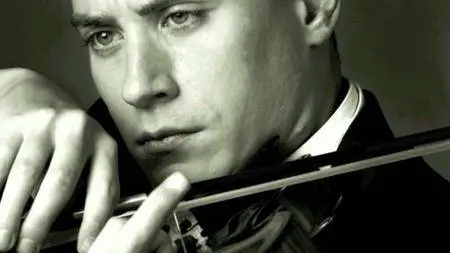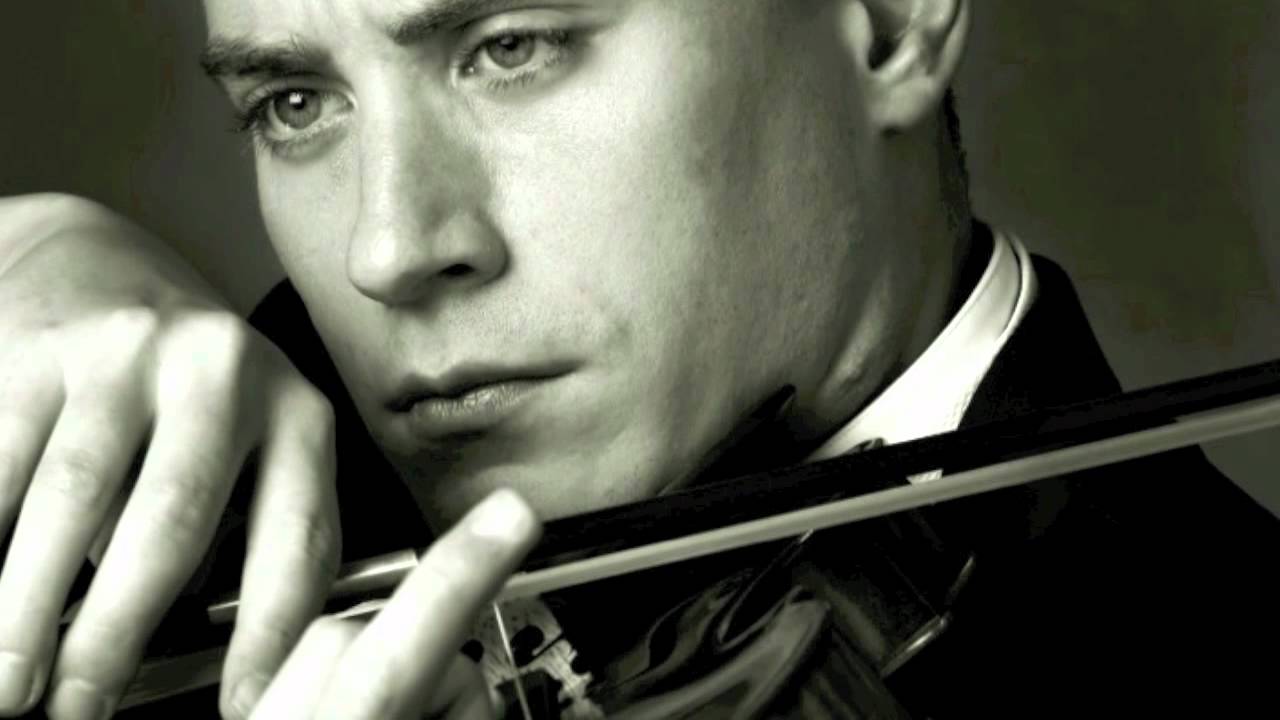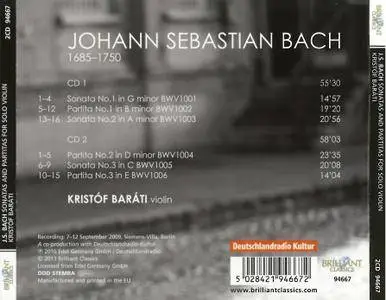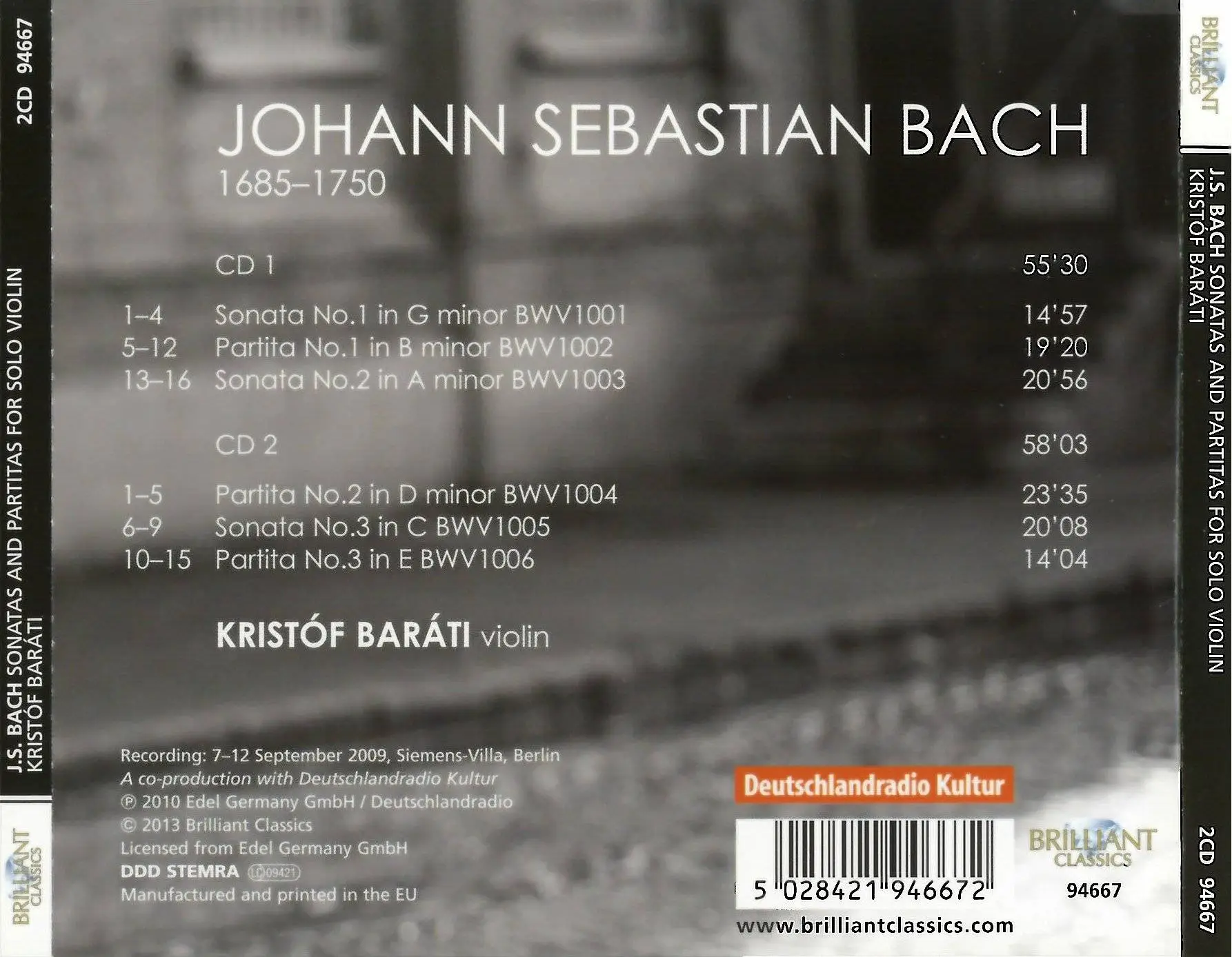Kristóf Baráti - J.S. Bach: Sonatas & Partitas for solo violin, BWV 1001-1006 (2009)
EAC | FLAC | Image (Cue&Log) ~ 604 Mb | MP3 (CBR320) ~ 267 Mb | Scans included
Genre: Classical | Label: Brilliant Classics | # 94667 | Time: 01:53:33
EAC | FLAC | Image (Cue&Log) ~ 604 Mb | MP3 (CBR320) ~ 267 Mb | Scans included
Genre: Classical | Label: Brilliant Classics | # 94667 | Time: 01:53:33
The star of the young Hungarian violinist Kristóf Baráti is quickly rising. Having won several important international competitions (the most recent first prize at the prestigious Paganini Competition in Moscow) he plays with important orchestras and conductors, like Charles Dutoit, Kurt Masur, Iván Fischer, Yuri Temirkanov and Marek Janowski.
His recent recording of Beethoven’s complete violin sonatas with Klára Würtz received rave reviews: “5 stars…a great duo, comparable with Perlman/Ashkenazy, Grumiaux/Haskil, Ferras/Barbizet’ (Diapason), “A talent that comes along once in a decade, perhaps once in a generation, I don’t say it lightly, but once you’ve heard Baráti and Würtz you’ll never listen to anyone else again” (Fanfare).
This recording of the great solo Bach was issued on Berlin Classics in 2009, and shows the sovereign command over the matter, and a deep understanding of the spirit of these masterworks.
Bach may well be one of the most widely acknowledged master composers of all time, but that only serves to make each performer’s interpretation of his work all the more challenging and distinctive: each musician must both do justice to the composer’s intention, making a decision as to the best way of conveying that within the music which is not fixed, and at the same time leave their own mark on the performance. This is especially true for these Sonatas and Partitas given the variety of styles in which such Baroque masterworks have been performed, ranging from the freely romantic to the strictly precise, and the technical challenge posed by these complex pieces for a single instrument. The works in this collection are something of an enigma, not only because of the uncertainty surrounding the circumstances and date of their composition, but, more crucially, because of the way in which they stretch the capacity for polyphony of a single violin beyond its physical limit. It is as though Bach had written for a full ensemble of instruments – but on a single staff. Modern musicians have even speculated as to the possible existence of a special bow with which an exact performance of the music might have been achieved in Bach’s day. The music is no less rich for all of this, however: on the contrary, the harmonic complexity of these pieces is at once captivating and beautiful; the implied but absent notes are thrillingly suggestive; and the multiplicity of voices leaves the listener marvelling at Bach’s compositional vision and the performer’s ability.
This accomplished musical feat is performed by Kristóf Baráti, a Hungarian violinist who has worked with an astonishing number of world‐famous orchestras and conductors. Baráti plays a 1703 Stradivarius violin, and one can sense this echo of the era of the pieces as much as one can his intense emotional involvement with the music.
For more than two centuries, the solo violin sonatas and partitas of J.S. Bach have been used as a benchmark to test the mettle of a violinist's technical and interpretive capabilities. Since recording technology first became available, countless violinists have laid down their own visions of these great works. The differences between the various approaches are vastly contrasting with no two agreeing on the "proper" way to perform Bach's masterpieces. Many violinists have even recorded the sonatas and partitas on more than one occasion as their interpretations and understanding of the scores have evolved over the course of their careers. For violinist Kristóf Baráti, this Berlin Classics release represents his second foray into Bach. What's unusual is the short interval between the two versions (only seven years) and the young age of the artist in both instances (Baráti was only 30 years old for this version). Here, Baráti's control over his instrument is clearly more developed than seven years ago, so there are fewer moments where technique is guiding interpretation. While Baráti plays with an abundance of technique and intensity, and tempos are more forward moving here than in his earlier attempt, it seems in places that a longer period of maturation may still have been in order before making a second attempt. Baráti's tone is robust and powerful but is sometimes heavy-handed, particularly with big, broken chords in the slower movements. His choice of faster tempos sometimes gets the better of him, as in the well-known D minor Chaconne, which seems hurried and impatient. Should Baráti choose to visit these works again – and there's no reason why he shouldn't – hopefully it will come after a longer period of growth and development.Review by Mike D. Brownell, Allmusic.com
My belated discovery of Kristóf Baráti came barely eight months ago when I received his Beethoven violin sonatas for review in 36:4. Rarely, if ever, have I been so awed by a violinist previously unknown to me, or by such indescribably stunning performances, that I concluded my review by suggesting that all other versions of the Beethoven sonatas had been rendered irrelevant. Them’s fighting words, I know, but I was so overwhelmed by Baráti’s playing that I begged for the opportunity to review his Bach Sonatas and Partitas, even though I knew they’d already been reviewed and urgently recommended by Robert Maxham in 34:1.
Baráti’s Bach was recorded in 2009 and originally released on Berlin Classics. Assuming you didn’t purchase it then at the full price of $33.99—which, by the way, you still can—it’s now available in this Brilliant Classics transfer for $11.99.
Most of what’s laudable about Baráti’s performances of Bach’s unaccompanied violin works was described in Maxham’s review, so rather than simply restate and endorse what was already said I’d like to expand upon it by addressing another aspect of Baráti’s readings.
It’s often said that Bach’s intent in these works was to mimic on the violin the contrapuntal interplay of lines more naturally suited to a keyboard instrument. The result is writing heavily reliant on double- and triple-stop chording and bow crossings that skip adjacent strings, requiring fingerings and bowings that run contrary to the physics of the violin and its fundamental design as a melody instrument. The three massive fugues—one in each of the four-movement chiesa -form sonatas—are particularly unrelenting in their contrapuntal demands. But even where there’s nary a double-stop in sight—the rapid-fire perpetual motion concluding movements of the three sonatas, the Gigue in the D-Minor Partita, and the Preludio in the E-Major Partita—the writing is such that a sequence of notes in a given measure is answered by a complementing sequence in a following measure, much as the right and left hands answer each other contrapuntally in Bach’s keyboard works. The trick on the violin is to manage these reciprocating volleys in a way that cons the ear into hearing two lines instead of one.
This sleight of hand can only be accomplished through a deft combination of phrasing, dynamics, and bowing articulation, and here is where Baráti really shines. This is one of those times when it would be especially helpful if we could offer actual musical examples, but I will have to do the best I can without them. In both the last movement of the C-Major Sonata, marked Allegro assai , and the first movement (Preludio) of the E-Major Partita, you have constant alternations between and alterations in bariolage-like figurations. In the former-noted movement, a figure rocking between the A and E strings is mirrored approximately in reverse two bars later on the D and A strings, giving the impression of the left hand answering the right. And through it all, there are accented forte downbeats that seem to pop out like the bass pedal on an organ. In all of the many performances of this movement I’ve heard, the only other violinist who manages to create the effect of this counterpointing interplay as sharply and as smartly as Baráti is Nathan Milstein in his later 1973 recording for Deutsche Grammophon.
In the latter-mentioned movement—the E-Major Sonata’s Preludio—you have that twice- occurring, right-brain vs. left-brain, bariolage passage in which the alternation occurs between an open string and higher notes played in a higher position on the string below it. It’s backwards and counterintuitive, but the thing to listen for is the last sixteenth note of each four sixteenth-note groupings. That’s the note that should pop out at the end of each beat like an ostinato bass note, and in Baráti’s performance, just listen starting at measure 21: wuh, wuh, wuh, wuh on each of those last sixteenths, so that by the time you get to the end of the passage at bar 28, your brain has mentally redrawn where the bar lines and the downbeats are. This is just another of Bach’s little rhythmic tricks to keep you constantly off balance.
Look at the last movement ( Presto ) of the G-Minor Sonata in a meter of 3/8. But there’s a constant shifting and regrouping of the six sixteenth notes per bar, so that sometimes they’re heard as triplets (two groups of three notes each), other times as duplets (three groups of two notes each), and still other times, slurred across bar-lines or regrouped in unexpected ways, like one, four, and one, dislocating the naturally accented beats altogether. Baráti takes it all in his stride, navigating the hairpin twists and turns with bow strokes of surgical precision and intonation so accurate it wouldn’t move the needle one cent or comma off center on a pitch detector.
As Maxham noted, Baráti’s Chaconne is a bit on the brisk side—13:05 to be exact, almost a full minute faster than the aforementioned Milstein and considerably faster than a number of other leading violinists, but still about 10 seconds slower than Heifetz—but delivered with such technical perfection, dignity, and nobility of spirit, it doesn’t sound rushed or pressed.
There is one thing, however, that Maxham failed to mention, and it’s the one thing that I find really disappointing, especially since there’s absolutely no rational explanation or excuse for it in these studio-made recordings. In every single binary-form movement, where you have first and second halves repeated, consistently and without exception, Baráti takes the first-half repeat but omits the second-half repeat. That affects a lot of movements: the last movement ( Presto ) of the G-Minor Sonata, every single movement of the B-Minor Partita, the third and fourth movements of the A-Minor Sonata, every movement of the D-Minor Partita (except for the Chaconne, which is not binary), the last movement of the C-Major Sonata, and the Louré, Menuets I and II, the Boureé, and the Gigue of the E-Major Partita. I simply can’t understand why Baráti made this choice; it’s not like the two discs are anywhere near capacity.
Would I reject Baráti’s Bach because of this? No, it’s simply too good to be doctrinaire about it, but for his fantabulous playing I could kiss him, while for his questionable of judgment, I could slap him. Still, these are performances of Bach’s Unaccompanied Sonatas and Partitas that everyone needs to hear, and I second, third, and fourth Maxham’s urgent recommendation.Review by Jerry Dubins, Fanfare
Tracklist:
CD1:
01. Sonata No.1 in G minor, BWV 1001 - I. Adagio (03:53)
02. Sonata No.1 in G minor, BWV 1001 - II. Fuga: Allegro (05:28)
03. Sonata No.1 in G minor, BWV 1001 - III. Siciliana (03:04)
04. Sonata No.1 in G minor, BWV 1001 - IV. Presto (02:39)
05. Partita No.1 in B minor, BWV 1002 - I. Adagio (04:24)
06. Partita No.1 in B minor, BWV 1002 - II. Double (02:10)
07. Partita No.1 in B minor, BWV 1002 - III. Corrente (02:15)
08. Partita No.1 in B minor, BWV 1002 - IV. Double: Presto (02:43)
09. Partita No.1 in B minor, BWV 1002 - V. Sarabande (01:52)
10. Partita No.1 in B minor, BWV 1002 - VI. Double (01:22)
11. Partita No.1 in B minor, BWV 1002 - VII. Tempo di Borea (02:15)
12. Partita No.1 in B minor, BWV 1002 - VIII. Double (02:24)
13. Sonata No.2 in A minor, BWV 1003 - I. Grave (03:50)
14. Sonata No.2 in A minor, BWV 1003 - II. Fuga (07:41)
15. Sonata No.2 in A minor, BWV 1003 - III. Andante (05:18)
16. Sonata No.2 in A minor, BWV 1003 - IV. Allegro (04:06)
CD2:
01. Partita No.2 in D minor, BWV 1004 - I. Allemanda (03:04)
02. Partita No.2 in D minor, BWV 1004 - II. Corrente (01:59)
03. Partita No.2 in D minor, BWV 1004 - III. Sarabanda (02:26)
04. Partita No.2 in D minor, BWV 1004 - IV. Giga (03:08)
05. Partita No.2 in D minor, BWV 1004 - V. Ciaccona (13:04)
06. Sonata No.3 in C major, BWV 1005 - I. Adagio (03:58)
07. Sonata No.3 in C major, BWV 1005 - II. Fuga (09:37)
08. Sonata No.3 in C major, BWV 1005 - III. Largo (03:03)
09. Sonata No.3 in C major, BWV 1005 - IV. Allegro assai (03:36)
10. Partita No.3 in E major, BWV 1006 - I. Preludio (03:50)
11. Partita No.3 in E major, BWV 1006 - II. Loure (02:47)
12. Partita No.3 in E major, BWV 1006 - III. Gavotte en Rondeau (02:47)
13. Partita No.3 in E major, BWV 1006 - IV. Menuet I, II (01:58)
14. Partita No.3 in E major, BWV 1006 - V. Bouree (01:06)
15. Partita No.3 in E major, BWV 1006 - VI. Gigue (01:33)
Exact Audio Copy V1.1 from 23. June 2015
EAC extraction logfile from 23. August 2015, 23:52
Kristóf Baráti / Bach - Sonatas and Partitas for Solo Violin - CD1
Used drive : HL-DT-STDVDRAM GU70N Adapter: 1 ID: 0
Read mode : Secure
Utilize accurate stream : Yes
Defeat audio cache : Yes
Make use of C2 pointers : No
Read offset correction : 48
Overread into Lead-In and Lead-Out : No
Fill up missing offset samples with silence : Yes
Delete leading and trailing silent blocks : No
Null samples used in CRC calculations : Yes
Used interface : Native Win32 interface for Win NT & 2000
Used output format : User Defined Encoder
Selected bitrate : 128 kBit/s
Quality : High
Add ID3 tag : No
Command line compressor : C:\Program Files (x86)\Exact Audio Copy\Flac\flac.exe
Additional command line options : -V -8 -T "Date=%year%" -T "Genre=%genre%" %source%
TOC of the extracted CD
Track | Start | Length | Start sector | End sector
––––––––––––––––––––––––––––-
1 | 0:00.00 | 3:53.14 | 0 | 17488
2 | 3:53.14 | 5:28.33 | 17489 | 42121
3 | 9:21.47 | 3:04.13 | 42122 | 55934
4 | 12:25.60 | 2:39.11 | 55935 | 67870
5 | 15:04.71 | 4:24.61 | 67871 | 87731
6 | 19:29.57 | 2:10.28 | 87732 | 97509
7 | 21:40.10 | 2:15.30 | 97510 | 107664
8 | 23:55.40 | 2:43.50 | 107665 | 119939
9 | 26:39.15 | 1:52.53 | 119940 | 128392
10 | 28:31.68 | 1:22.02 | 128393 | 134544
11 | 29:53.70 | 2:15.68 | 134545 | 144737
12 | 32:09.63 | 2:24.14 | 144738 | 155551
13 | 34:34.02 | 3:50.29 | 155552 | 172830
14 | 38:24.31 | 7:41.59 | 172831 | 207464
15 | 46:06.15 | 5:18.06 | 207465 | 231320
16 | 51:24.21 | 4:06.02 | 231321 | 249772
Range status and errors
Selected range
Filename C:\temp\Bach - Sonatas and Partitas for Solo Violin - Barati\CD1\Bach - Sonatas and Partitas for Solo Violin - CD1.wav
Peak level 100.0 %
Extraction speed 2.0 X
Range quality 99.9 %
Test CRC 0A5C1A0B
Copy CRC 0A5C1A0B
Copy OK
No errors occurred
AccurateRip summary
Track 1 accurately ripped (confidence 5) [F289A39D] (AR v2)
Track 2 accurately ripped (confidence 5) [47FFD8B7] (AR v2)
Track 3 accurately ripped (confidence 5) [BEAE62CE] (AR v2)
Track 4 accurately ripped (confidence 5) [B13156F6] (AR v2)
Track 5 accurately ripped (confidence 5) [E68837E5] (AR v2)
Track 6 accurately ripped (confidence 5) [AD93E2FE] (AR v2)
Track 7 accurately ripped (confidence 5) [00DB3EE6] (AR v2)
Track 8 accurately ripped (confidence 5) [7632D9EC] (AR v2)
Track 9 accurately ripped (confidence 5) [08DF8398] (AR v2)
Track 10 accurately ripped (confidence 5) [B1ED13D4] (AR v2)
Track 11 accurately ripped (confidence 5) [363FFE9F] (AR v2)
Track 12 accurately ripped (confidence 5) [55787485] (AR v2)
Track 13 accurately ripped (confidence 5) [911B18AF] (AR v2)
Track 14 accurately ripped (confidence 5) [2DB2D091] (AR v2)
Track 15 accurately ripped (confidence 5) [66F495EC] (AR v2)
Track 16 accurately ripped (confidence 5) [031C43FC] (AR v2)
All tracks accurately ripped
End of status report
==== Log checksum A668A16666666B344EA29C440AC856F4425241280A7AF3E4E0012E89285D24EE ====
EAC extraction logfile from 23. August 2015, 23:52
Kristóf Baráti / Bach - Sonatas and Partitas for Solo Violin - CD1
Used drive : HL-DT-STDVDRAM GU70N Adapter: 1 ID: 0
Read mode : Secure
Utilize accurate stream : Yes
Defeat audio cache : Yes
Make use of C2 pointers : No
Read offset correction : 48
Overread into Lead-In and Lead-Out : No
Fill up missing offset samples with silence : Yes
Delete leading and trailing silent blocks : No
Null samples used in CRC calculations : Yes
Used interface : Native Win32 interface for Win NT & 2000
Used output format : User Defined Encoder
Selected bitrate : 128 kBit/s
Quality : High
Add ID3 tag : No
Command line compressor : C:\Program Files (x86)\Exact Audio Copy\Flac\flac.exe
Additional command line options : -V -8 -T "Date=%year%" -T "Genre=%genre%" %source%
TOC of the extracted CD
Track | Start | Length | Start sector | End sector
––––––––––––––––––––––––––––-
1 | 0:00.00 | 3:53.14 | 0 | 17488
2 | 3:53.14 | 5:28.33 | 17489 | 42121
3 | 9:21.47 | 3:04.13 | 42122 | 55934
4 | 12:25.60 | 2:39.11 | 55935 | 67870
5 | 15:04.71 | 4:24.61 | 67871 | 87731
6 | 19:29.57 | 2:10.28 | 87732 | 97509
7 | 21:40.10 | 2:15.30 | 97510 | 107664
8 | 23:55.40 | 2:43.50 | 107665 | 119939
9 | 26:39.15 | 1:52.53 | 119940 | 128392
10 | 28:31.68 | 1:22.02 | 128393 | 134544
11 | 29:53.70 | 2:15.68 | 134545 | 144737
12 | 32:09.63 | 2:24.14 | 144738 | 155551
13 | 34:34.02 | 3:50.29 | 155552 | 172830
14 | 38:24.31 | 7:41.59 | 172831 | 207464
15 | 46:06.15 | 5:18.06 | 207465 | 231320
16 | 51:24.21 | 4:06.02 | 231321 | 249772
Range status and errors
Selected range
Filename C:\temp\Bach - Sonatas and Partitas for Solo Violin - Barati\CD1\Bach - Sonatas and Partitas for Solo Violin - CD1.wav
Peak level 100.0 %
Extraction speed 2.0 X
Range quality 99.9 %
Test CRC 0A5C1A0B
Copy CRC 0A5C1A0B
Copy OK
No errors occurred
AccurateRip summary
Track 1 accurately ripped (confidence 5) [F289A39D] (AR v2)
Track 2 accurately ripped (confidence 5) [47FFD8B7] (AR v2)
Track 3 accurately ripped (confidence 5) [BEAE62CE] (AR v2)
Track 4 accurately ripped (confidence 5) [B13156F6] (AR v2)
Track 5 accurately ripped (confidence 5) [E68837E5] (AR v2)
Track 6 accurately ripped (confidence 5) [AD93E2FE] (AR v2)
Track 7 accurately ripped (confidence 5) [00DB3EE6] (AR v2)
Track 8 accurately ripped (confidence 5) [7632D9EC] (AR v2)
Track 9 accurately ripped (confidence 5) [08DF8398] (AR v2)
Track 10 accurately ripped (confidence 5) [B1ED13D4] (AR v2)
Track 11 accurately ripped (confidence 5) [363FFE9F] (AR v2)
Track 12 accurately ripped (confidence 5) [55787485] (AR v2)
Track 13 accurately ripped (confidence 5) [911B18AF] (AR v2)
Track 14 accurately ripped (confidence 5) [2DB2D091] (AR v2)
Track 15 accurately ripped (confidence 5) [66F495EC] (AR v2)
Track 16 accurately ripped (confidence 5) [031C43FC] (AR v2)
All tracks accurately ripped
End of status report
==== Log checksum A668A16666666B344EA29C440AC856F4425241280A7AF3E4E0012E89285D24EE ====
foobar2000 1.2 / Dynamic Range Meter 1.1.1
log date: 2016-06-10 19:25:54
––––––––––––––––––––––––––––––––––––––––
Analyzed: Kristуf Barбti / Bach - Sonatas and Partitas for Solo Violin - CD1
––––––––––––––––––––––––––––––––––––––––
DR Peak RMS Duration Track
––––––––––––––––––––––––––––––––––––––––
DR13 -4.41 dB -22.42 dB 3:53 01-Sonata No.1 in G minor, BWV 1001 - I. Adagio
DR13 -0.16 dB -16.84 dB 5:28 02-Sonata No.1 in G minor, BWV 1001 - II. Fuga: Allegro
DR13 -3.89 dB -21.36 dB 3:04 03-Sonata No.1 in G minor, BWV 1001 - III. Siciliana
DR13 -0.38 dB -19.71 dB 2:39 04-Sonata No.1 in G minor, BWV 1001 - IV. Presto
DR13 -2.29 dB -19.17 dB 4:25 05-Partita No.1 in B minor, BWV 1002 - I. Adagio
DR11 -5.29 dB -20.52 dB 2:10 06-Partita No.1 in B minor, BWV 1002 - II. Double
DR13 -3.84 dB -20.27 dB 2:15 07-Partita No.1 in B minor, BWV 1002 - III. Corrente
DR13 -4.04 dB -19.71 dB 2:44 08-Partita No.1 in B minor, BWV 1002 - IV. Double: Presto
DR11 -3.25 dB -19.15 dB 1:53 09-Partita No.1 in B minor, BWV 1002 - V. Sarabande
DR11 -3.46 dB -20.23 dB 1:22 10-Partita No.1 in B minor, BWV 1002 - VI. Double
DR14 -0.32 dB -17.64 dB 2:16 11-Partita No.1 in B minor, BWV 1002 - VII. Tempo di Borea
DR12 -3.70 dB -19.04 dB 2:24 12-Partita No.1 in B minor, BWV 1002 - VIII. Double
DR13 -4.20 dB -21.15 dB 3:50 13-Sonata No.2 in A minor, BWV 1003 - I. Grave
DR13 0.00 dB -16.45 dB 7:42 14-Sonata No.2 in A minor, BWV 1003 - II. Fuga
DR13 -3.70 dB -21.48 dB 5:18 15-Sonata No.2 in A minor, BWV 1003 - III. Andante
DR12 -2.65 dB -18.25 dB 4:06 16-Sonata No.2 in A minor, BWV 1003 - IV. Allegro
––––––––––––––––––––––––––––––––––––––––
Number of tracks: 16
Official DR value: DR13
Samplerate: 44100 Hz
Channels: 2
Bits per sample: 16
Bitrate: 740 kbps
Codec: FLAC
================================================================================
log date: 2016-06-10 19:25:54
––––––––––––––––––––––––––––––––––––––––
Analyzed: Kristуf Barбti / Bach - Sonatas and Partitas for Solo Violin - CD1
––––––––––––––––––––––––––––––––––––––––
DR Peak RMS Duration Track
––––––––––––––––––––––––––––––––––––––––
DR13 -4.41 dB -22.42 dB 3:53 01-Sonata No.1 in G minor, BWV 1001 - I. Adagio
DR13 -0.16 dB -16.84 dB 5:28 02-Sonata No.1 in G minor, BWV 1001 - II. Fuga: Allegro
DR13 -3.89 dB -21.36 dB 3:04 03-Sonata No.1 in G minor, BWV 1001 - III. Siciliana
DR13 -0.38 dB -19.71 dB 2:39 04-Sonata No.1 in G minor, BWV 1001 - IV. Presto
DR13 -2.29 dB -19.17 dB 4:25 05-Partita No.1 in B minor, BWV 1002 - I. Adagio
DR11 -5.29 dB -20.52 dB 2:10 06-Partita No.1 in B minor, BWV 1002 - II. Double
DR13 -3.84 dB -20.27 dB 2:15 07-Partita No.1 in B minor, BWV 1002 - III. Corrente
DR13 -4.04 dB -19.71 dB 2:44 08-Partita No.1 in B minor, BWV 1002 - IV. Double: Presto
DR11 -3.25 dB -19.15 dB 1:53 09-Partita No.1 in B minor, BWV 1002 - V. Sarabande
DR11 -3.46 dB -20.23 dB 1:22 10-Partita No.1 in B minor, BWV 1002 - VI. Double
DR14 -0.32 dB -17.64 dB 2:16 11-Partita No.1 in B minor, BWV 1002 - VII. Tempo di Borea
DR12 -3.70 dB -19.04 dB 2:24 12-Partita No.1 in B minor, BWV 1002 - VIII. Double
DR13 -4.20 dB -21.15 dB 3:50 13-Sonata No.2 in A minor, BWV 1003 - I. Grave
DR13 0.00 dB -16.45 dB 7:42 14-Sonata No.2 in A minor, BWV 1003 - II. Fuga
DR13 -3.70 dB -21.48 dB 5:18 15-Sonata No.2 in A minor, BWV 1003 - III. Andante
DR12 -2.65 dB -18.25 dB 4:06 16-Sonata No.2 in A minor, BWV 1003 - IV. Allegro
––––––––––––––––––––––––––––––––––––––––
Number of tracks: 16
Official DR value: DR13
Samplerate: 44100 Hz
Channels: 2
Bits per sample: 16
Bitrate: 740 kbps
Codec: FLAC
================================================================================
Exact Audio Copy V1.1 from 23. June 2015
EAC extraction logfile from 24. August 2015, 8:43
Kristóf Baráti / Bach - Sonatas and Partitas for Solo Violin - CD2
Used drive : HL-DT-STDVDRAM GU70N Adapter: 1 ID: 0
Read mode : Secure
Utilize accurate stream : Yes
Defeat audio cache : Yes
Make use of C2 pointers : No
Read offset correction : 48
Overread into Lead-In and Lead-Out : No
Fill up missing offset samples with silence : Yes
Delete leading and trailing silent blocks : No
Null samples used in CRC calculations : Yes
Used interface : Native Win32 interface for Win NT & 2000
Used output format : User Defined Encoder
Selected bitrate : 128 kBit/s
Quality : High
Add ID3 tag : No
Command line compressor : C:\Program Files (x86)\Exact Audio Copy\Flac\flac.exe
Additional command line options : -V -8 -T "Date=%year%" -T "Genre=%genre%" %source%
TOC of the extracted CD
Track | Start | Length | Start sector | End sector
––––––––––––––––––––––––––––-
1 | 0:00.00 | 3:04.34 | 0 | 13833
2 | 3:04.34 | 1:59.26 | 13834 | 22784
3 | 5:03.60 | 2:26.67 | 22785 | 33801
4 | 7:30.52 | 3:08.11 | 33802 | 47912
5 | 10:38.63 | 13:04.47 | 47913 | 106759
6 | 23:43.35 | 3:58.38 | 106760 | 124647
7 | 27:41.73 | 9:37.73 | 124648 | 167995
8 | 37:19.71 | 3:03.37 | 167996 | 181757
9 | 40:23.33 | 3:36.14 | 181758 | 197971
10 | 43:59.47 | 3:50.20 | 197972 | 215241
11 | 47:49.67 | 2:47.45 | 215242 | 227811
12 | 50:37.37 | 2:47.14 | 227812 | 240350
13 | 53:24.51 | 1:58.52 | 240351 | 249252
14 | 55:23.28 | 1:06.43 | 249253 | 254245
15 | 56:29.71 | 1:33.37 | 254246 | 261257
Range status and errors
Selected range
Filename C:\temp\Bach - Sonatas and Partitas for Solo Violin - Barati\CD2\Bach - Sonatas and Partitas for Solo Violin - CD2.wav
Peak level 100.0 %
Extraction speed 2.1 X
Range quality 100.0 %
Test CRC 6A144056
Copy CRC 6A144056
Copy OK
No errors occurred
AccurateRip summary
Track 1 accurately ripped (confidence 5) [BAC45CFF] (AR v2)
Track 2 accurately ripped (confidence 5) [09A6C120] (AR v2)
Track 3 accurately ripped (confidence 5) [542AF34F] (AR v2)
Track 4 accurately ripped (confidence 5) [F5045518] (AR v2)
Track 5 accurately ripped (confidence 5) [6AE99554] (AR v2)
Track 6 accurately ripped (confidence 5) [737B6F28] (AR v2)
Track 7 accurately ripped (confidence 5) [E0A36D4D] (AR v2)
Track 8 accurately ripped (confidence 5) [8C15FE1C] (AR v2)
Track 9 accurately ripped (confidence 5) [6264DD5E] (AR v2)
Track 10 accurately ripped (confidence 5) [5F5BBFAB] (AR v2)
Track 11 accurately ripped (confidence 5) [752B376D] (AR v2)
Track 12 accurately ripped (confidence 5) [CE9E7072] (AR v2)
Track 13 accurately ripped (confidence 5) [7072D679] (AR v2)
Track 14 accurately ripped (confidence 5) [92115740] (AR v2)
Track 15 accurately ripped (confidence 5) [30F9FAF2] (AR v2)
All tracks accurately ripped
End of status report
==== Log checksum 47EEC97F56B38275961A11DDB57214874DC4D910EE3126C31F1D79E6D2516A6F ====
EAC extraction logfile from 24. August 2015, 8:43
Kristóf Baráti / Bach - Sonatas and Partitas for Solo Violin - CD2
Used drive : HL-DT-STDVDRAM GU70N Adapter: 1 ID: 0
Read mode : Secure
Utilize accurate stream : Yes
Defeat audio cache : Yes
Make use of C2 pointers : No
Read offset correction : 48
Overread into Lead-In and Lead-Out : No
Fill up missing offset samples with silence : Yes
Delete leading and trailing silent blocks : No
Null samples used in CRC calculations : Yes
Used interface : Native Win32 interface for Win NT & 2000
Used output format : User Defined Encoder
Selected bitrate : 128 kBit/s
Quality : High
Add ID3 tag : No
Command line compressor : C:\Program Files (x86)\Exact Audio Copy\Flac\flac.exe
Additional command line options : -V -8 -T "Date=%year%" -T "Genre=%genre%" %source%
TOC of the extracted CD
Track | Start | Length | Start sector | End sector
––––––––––––––––––––––––––––-
1 | 0:00.00 | 3:04.34 | 0 | 13833
2 | 3:04.34 | 1:59.26 | 13834 | 22784
3 | 5:03.60 | 2:26.67 | 22785 | 33801
4 | 7:30.52 | 3:08.11 | 33802 | 47912
5 | 10:38.63 | 13:04.47 | 47913 | 106759
6 | 23:43.35 | 3:58.38 | 106760 | 124647
7 | 27:41.73 | 9:37.73 | 124648 | 167995
8 | 37:19.71 | 3:03.37 | 167996 | 181757
9 | 40:23.33 | 3:36.14 | 181758 | 197971
10 | 43:59.47 | 3:50.20 | 197972 | 215241
11 | 47:49.67 | 2:47.45 | 215242 | 227811
12 | 50:37.37 | 2:47.14 | 227812 | 240350
13 | 53:24.51 | 1:58.52 | 240351 | 249252
14 | 55:23.28 | 1:06.43 | 249253 | 254245
15 | 56:29.71 | 1:33.37 | 254246 | 261257
Range status and errors
Selected range
Filename C:\temp\Bach - Sonatas and Partitas for Solo Violin - Barati\CD2\Bach - Sonatas and Partitas for Solo Violin - CD2.wav
Peak level 100.0 %
Extraction speed 2.1 X
Range quality 100.0 %
Test CRC 6A144056
Copy CRC 6A144056
Copy OK
No errors occurred
AccurateRip summary
Track 1 accurately ripped (confidence 5) [BAC45CFF] (AR v2)
Track 2 accurately ripped (confidence 5) [09A6C120] (AR v2)
Track 3 accurately ripped (confidence 5) [542AF34F] (AR v2)
Track 4 accurately ripped (confidence 5) [F5045518] (AR v2)
Track 5 accurately ripped (confidence 5) [6AE99554] (AR v2)
Track 6 accurately ripped (confidence 5) [737B6F28] (AR v2)
Track 7 accurately ripped (confidence 5) [E0A36D4D] (AR v2)
Track 8 accurately ripped (confidence 5) [8C15FE1C] (AR v2)
Track 9 accurately ripped (confidence 5) [6264DD5E] (AR v2)
Track 10 accurately ripped (confidence 5) [5F5BBFAB] (AR v2)
Track 11 accurately ripped (confidence 5) [752B376D] (AR v2)
Track 12 accurately ripped (confidence 5) [CE9E7072] (AR v2)
Track 13 accurately ripped (confidence 5) [7072D679] (AR v2)
Track 14 accurately ripped (confidence 5) [92115740] (AR v2)
Track 15 accurately ripped (confidence 5) [30F9FAF2] (AR v2)
All tracks accurately ripped
End of status report
==== Log checksum 47EEC97F56B38275961A11DDB57214874DC4D910EE3126C31F1D79E6D2516A6F ====
foobar2000 1.2 / Dynamic Range Meter 1.1.1
log date: 2016-06-10 19:26:11
––––––––––––––––––––––––––––––––––––––––
Analyzed: Kristуf Barбti / Bach - Sonatas and Partitas for Solo Violin - CD2
––––––––––––––––––––––––––––––––––––––––
DR Peak RMS Duration Track
––––––––––––––––––––––––––––––––––––––––
DR12 -3.65 dB -20.55 dB 3:04 01-Partita No.2 in D minor, BWV 1004 - I. Allemanda
DR14 -4.86 dB -21.95 dB 1:59 02-Partita No.2 in D minor, BWV 1004 - II. Corrente
DR12 -7.04 dB -23.37 dB 2:27 03-Partita No.2 in D minor, BWV 1004 - III. Sarabanda
DR13 -4.30 dB -20.13 dB 3:08 04-Partita No.2 in D minor, BWV 1004 - IV. Giga
DR13 -1.07 dB -18.89 dB 13:05 05-Partita No.2 in D minor, BWV 1004 - V. Ciaccona
DR13 -2.74 dB -20.23 dB 3:59 06-Sonata No.3 in C major, BWV 1005 - I. Adagio
DR13 0.00 dB -16.40 dB 9:38 07-Sonata No.3 in C major, BWV 1005 - II. Fuga
DR13 -5.05 dB -23.14 dB 3:03 08-Sonata No.3 in C major, BWV 1005 - III. Largo
DR13 -4.11 dB -20.74 dB 3:36 09-Sonata No.3 in C major, BWV 1005 - IV. Allegro assai
DR13 -1.78 dB -19.30 dB 3:50 10-Partita No.3 in E major, BWV 1006 - I. Preludio
DR13 -5.89 dB -22.16 dB 2:48 11-Partita No.3 in E major, BWV 1006 - II. Loure
DR13 -1.90 dB -19.88 dB 2:47 12-Partita No.3 in E major, BWV 1006 - III. Gavotte en Rondeau
DR13 -4.57 dB -21.35 dB 1:59 13-Partita No.3 in E major, BWV 1006 - IV. Menuet I, II
DR13 -3.13 dB -20.81 dB 1:07 14-Partita No.3 in E major, BWV 1006 - V. Bourйe
DR13 -4.88 dB -21.14 dB 1:33 15-Partita No.3 in E major, BWV 1006 - VI. Gigue
––––––––––––––––––––––––––––––––––––––––
Number of tracks: 15
Official DR value: DR13
Samplerate: 44100 Hz
Channels: 2
Bits per sample: 16
Bitrate: 730 kbps
Codec: FLAC
================================================================================
log date: 2016-06-10 19:26:11
––––––––––––––––––––––––––––––––––––––––
Analyzed: Kristуf Barбti / Bach - Sonatas and Partitas for Solo Violin - CD2
––––––––––––––––––––––––––––––––––––––––
DR Peak RMS Duration Track
––––––––––––––––––––––––––––––––––––––––
DR12 -3.65 dB -20.55 dB 3:04 01-Partita No.2 in D minor, BWV 1004 - I. Allemanda
DR14 -4.86 dB -21.95 dB 1:59 02-Partita No.2 in D minor, BWV 1004 - II. Corrente
DR12 -7.04 dB -23.37 dB 2:27 03-Partita No.2 in D minor, BWV 1004 - III. Sarabanda
DR13 -4.30 dB -20.13 dB 3:08 04-Partita No.2 in D minor, BWV 1004 - IV. Giga
DR13 -1.07 dB -18.89 dB 13:05 05-Partita No.2 in D minor, BWV 1004 - V. Ciaccona
DR13 -2.74 dB -20.23 dB 3:59 06-Sonata No.3 in C major, BWV 1005 - I. Adagio
DR13 0.00 dB -16.40 dB 9:38 07-Sonata No.3 in C major, BWV 1005 - II. Fuga
DR13 -5.05 dB -23.14 dB 3:03 08-Sonata No.3 in C major, BWV 1005 - III. Largo
DR13 -4.11 dB -20.74 dB 3:36 09-Sonata No.3 in C major, BWV 1005 - IV. Allegro assai
DR13 -1.78 dB -19.30 dB 3:50 10-Partita No.3 in E major, BWV 1006 - I. Preludio
DR13 -5.89 dB -22.16 dB 2:48 11-Partita No.3 in E major, BWV 1006 - II. Loure
DR13 -1.90 dB -19.88 dB 2:47 12-Partita No.3 in E major, BWV 1006 - III. Gavotte en Rondeau
DR13 -4.57 dB -21.35 dB 1:59 13-Partita No.3 in E major, BWV 1006 - IV. Menuet I, II
DR13 -3.13 dB -20.81 dB 1:07 14-Partita No.3 in E major, BWV 1006 - V. Bourйe
DR13 -4.88 dB -21.14 dB 1:33 15-Partita No.3 in E major, BWV 1006 - VI. Gigue
––––––––––––––––––––––––––––––––––––––––
Number of tracks: 15
Official DR value: DR13
Samplerate: 44100 Hz
Channels: 2
Bits per sample: 16
Bitrate: 730 kbps
Codec: FLAC
================================================================================




